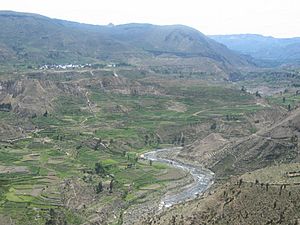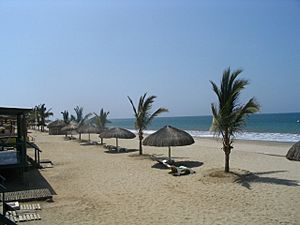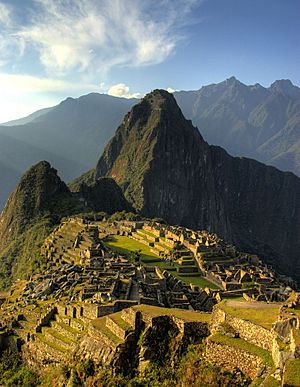List of protected areas of Peru facts for kids
Peru is a country with amazing natural resources and many different types of ecosystems. To protect these special places, Peru has created many protected areas. These areas help keep the country's unique plants and animals safe for the future.
In 1990, Peru set up the National System of Natural Areas Protected by the Government, called SINANPE. This system is managed by the National Service of Protected Areas by the State (SERNANP), which is part of the Ministry of Environment.
Peru has 76 natural protected areas, covering more than 15% of the country! These include national parks, national sanctuaries, national reserves, and more. Peru is one of the 17 "megadiverse countries" in the world, meaning it has a huge variety of life. For example, it has the second-highest number of bird species in the world, with over 1,850!
Contents
Types of Protected Areas
National Parks
National Parks are special places where wild flora (plants) and fauna (animals) are kept safe. In these parks, people are not allowed to use the natural resources or build homes. They are strictly for conservation.
- Cutervo
* Created in 1961, this is Peru's oldest National Park. * It's in the Cajamarca area. * The park has many caves, like the San Andres Cave. * These caves are home to the endangered guacharo (oilbird) and the beautiful golden quetzal.
- Tingo María
* You can find this park in the Huanuco Region. * Its main attraction is the Cueva de las Lechuzas (Owl Cave). * This cave is another important home for the guacharo bird.
- Manu
* This huge park is in the Madre de Dios and Cuzco Regions. * In 1977, UNESCO called it a Reserve of Biosphere. * Then, in 1987, it was named a Natural Heritage of Humanity.
* Located in Ancash. * It's also a Natural Heritage of Humanity and a Reserve of Biosphere. * Peru's highest snow-covered mountain, Huascarán (6,768 meters), is here. * The park is home to the unique Puya raimondii plant. * You can also find animals like the cougar, jaguar, llama, guanaco, and Peruvian tapir.
- Cerros de Amotape
* This park is in Piura and Tumbes. * It has many dry forests. * Endangered animals like the American crocodile live here.
* Another Natural and Cultural Heritage of Humanity site. * It's located in San Martín.
- Yanachaga–Chemillén
* This tropical forest is in Pasco Region at 4,800 meters. * Rivers like the Palcazu River flow through it. * Some native communities still live here. * You can also find old Inca and Yanesha archaeological sites.
- Bahuaja-Sonene
* Found in Madre de Dios. * It includes tropical forests and part of the Tambopata National Reserve.
- Cordillera Azul
- Otishi
- Alto Purús
- Ichigkat muja – Cordillera del Condor
- Güeppí Sekime
- Sierra del Divisor
* Created in 2015. * It's in Loreto and Ucayali, near the border with Brazil.
- Yaguas
* Created in 2018. * This tropical forest protection zone is along the Yaguas river in Loreto, close to Colombia.
National Reserves

National Reserves are areas that protect specific ecosystems and species, while also allowing some sustainable use of resources.
- Pampa Galeras – Barbara D'Achille
* Located in Ayacucho. * It's an important home for the vicuña.
- Junin
* Found in Junín. * Its main goal is to protect the ecosystem and living things around Lake Junín.
* In Ica. * It protects the sea ecosystem and the area's historical and cultural sites.
- Lachay
* Located in Lima. * It aims to bring back and protect the ecosystem of the Lomas de Lachay (Lachay Hills).
- Titicaca
* In Puno. * Its main purpose is to keep Lake Titicaca's ecosystems and beautiful landscape safe.
- Salinas and Aguada Blanca
* Found in Arequipa and Moquegua. * They protect plants, animals, and the natural scenery.
- Calipuy
* Located in La Libertad. * Its main goal is to protect populations of guanacos.
- Pacaya-Samiria
* In Loreto. * It protects the ecosystems of the Omagua Region and supports the local indigenous communities.
- Tambopata
- Allpahuayo-Mishana
- Tumbes
- Matsés National Reserve
- System of Islands, Islets and Guano Sites National Reserve
- Pucacuro
- San Fernando National Reserve
National Sanctuaries
National sanctuaries are important areas that protect the homes of specific plants and animals. They also preserve natural formations that are interesting for science or just beautiful to look at.
- Huayllay
- Calipuy
- Mejía Lagoons
- Ampay
- Manglares de Tumbes ("Mangroves of Tumbes")
- Megantoni
- Pampa Hermosa
- Tabacones Namballe
- Cordillera de Colán
Historical Sanctuaries
Historical sanctuaries protect places that are important for Peru's history and culture, often alongside natural features.
- Chacramarca
- Pampas de Ayacucho ("Pampas of Ayacucho")
- Machu Picchu
- Pómac Forest
Wildlife Refuges
Wildlife refuges are areas set aside to protect specific wildlife species and their habitats.
- Laquipampa
- Pantanos de Villa
- Udima Cloud Forests Wildlife Refuge
Landscape Reserves
Landscape reserves protect beautiful and unique natural landscapes, often with cultural significance.
- Nor Yauyos-Cochas
- Cotahuasi Subbasin
- Qhapiya Landscape Reserve
Communal Reserves
Communal reserves are special conservation areas for plants and animals. The local communities living nearby are allowed to use the natural resources in traditional ways. They also help manage and sell these resources.
| Reserve | Date | Area (ha) |
|---|---|---|
| Yanesha | 28 April 1988 | 34,744 |
| El Sira | 22 June 2001 | 616,413 |
| Amarakaeri | 9 May 2002 | 402,335 |
| Asháninka | 14 January 2003 | 184,468 |
| Machiguenga | 14 January 2003 | 218,905 |
| Purús | 20 November 2004 | 202,033 |
| Tuntanain | 10 August 2007 | 94,967 |
| Chayu Nain | 9 December 2009 | 23,597 |
Protected Forests
These forests are protected to keep their ecosystems healthy and to prevent things like soil erosion.
- Aledaño Bocatoma del Canal Nuevo Imperial ("Adjacent to the Nuevo Imperial Canal Intake")
- Puquio Santa Rosa ("Santa Rosa (Water) Spring")
- Pui–Pui
- San Matías–San Carlos
- Pagaibamba
- Alto Mayo
Enclosed Hunting Lands
These areas are managed for controlled hunting, often to help manage animal populations.
- El Angolo
- Sunchubamba
Reserved Zones
Reserved zones are areas that are being studied to decide what kind of protected area they should become in the future.
- Chancaybaños
- Güeppí
- Santiago-Comaina
- Waywash mountain range
- Sierra del Divisor Reserved Zone
- Humedales de Puerto Viejo Reserved Zone
- Nieva River Reserved Zone
- Lomas de Ancón Reserved Zone
- Bosque de Zárate Reserved Zone
- Illescas Reserved Zone
- Yaguas Reserved Zone
- Ancón Reserved Zone
- Huacachina Reserved Zone
National Forests
National forests are large areas of forest managed for timber production, conservation, and other uses.
- Biabo Cordillera Azul
- Mariscal Cáceres
- Pastaza–Morona–Marañon
- Alexander von Humboldt
Areas of Regional Conservation
These areas are protected by regional governments, often focusing on specific local conservation needs.
- Chuqik'iraw
- Tamshiyacu Tahuayo
- Titankayuq
- Waytapallana
See also
 In Spanish: Áreas naturales protegidas del Perú para niños
In Spanish: Áreas naturales protegidas del Perú para niños
- Iperu, tourist information and assistance
- Tourism in Peru




